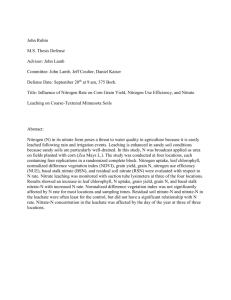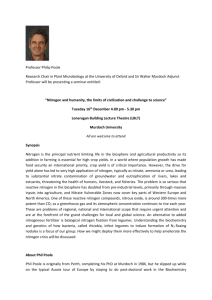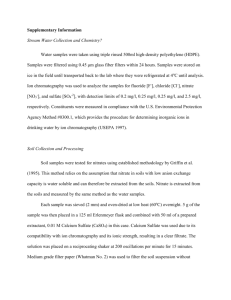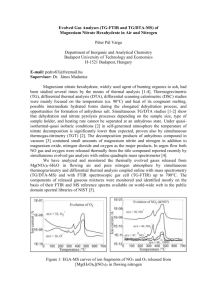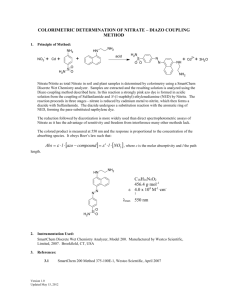Nodulation and Nitrogen Fixation - Centre for Integrative Legume
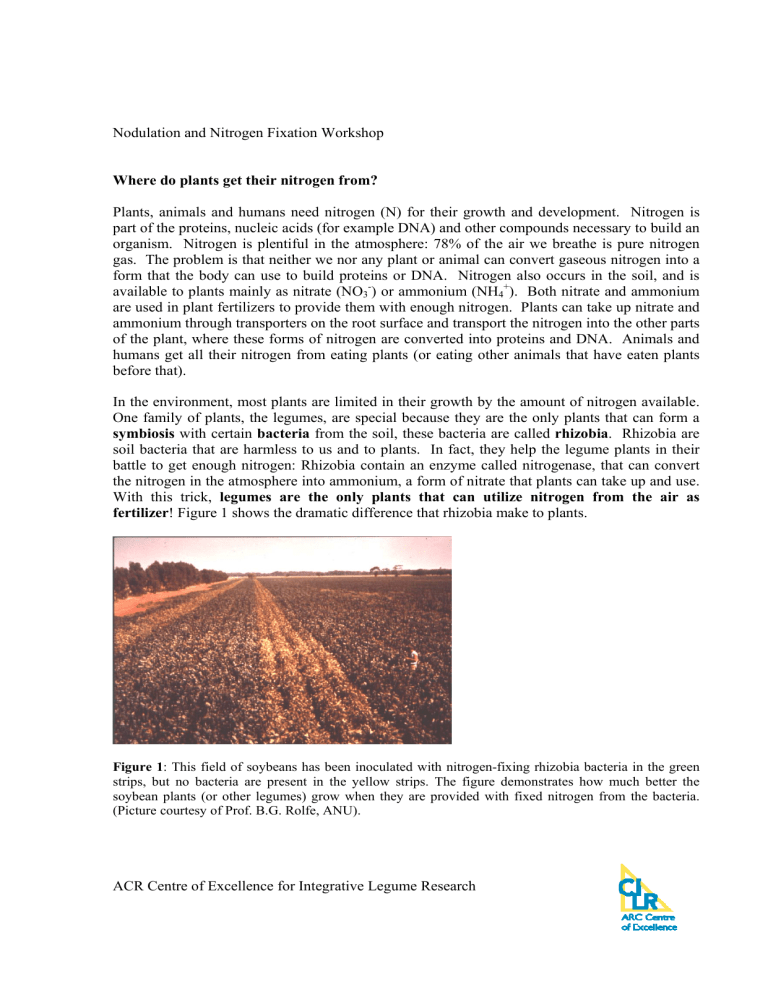
Nodulation and Nitrogen Fixation Workshop
Where do plants get their nitrogen from?
Plants, animals and humans need nitrogen (N) for their growth and development. Nitrogen is part of the proteins, nucleic acids (for example DNA) and other compounds necessary to build an organism. Nitrogen is plentiful in the atmosphere: 78% of the air we breathe is pure nitrogen gas. The problem is that neither we nor any plant or animal can convert gaseous nitrogen into a form that the body can use to build proteins or DNA. Nitrogen also occurs in the soil, and is available to plants mainly as nitrate (NO
3
-
) or ammonium (NH
4
+
). Both nitrate and ammonium are used in plant fertilizers to provide them with enough nitrogen. Plants can take up nitrate and ammonium through transporters on the root surface and transport the nitrogen into the other parts of the plant, where these forms of nitrogen are converted into proteins and DNA. Animals and humans get all their nitrogen from eating plants (or eating other animals that have eaten plants before that).
In the environment, most plants are limited in their growth by the amount of nitrogen available.
One family of plants, the legumes, are special because they are the only plants that can form a symbiosis with certain bacteria from the soil, these bacteria are called rhizobia . Rhizobia are soil bacteria that are harmless to us and to plants. In fact, they help the legume plants in their battle to get enough nitrogen: Rhizobia contain an enzyme called nitrogenase, that can convert the nitrogen in the atmosphere into ammonium, a form of nitrate that plants can take up and use.
With this trick, legumes are the only plants that can utilize nitrogen from the air as fertilizer ! Figure 1 shows the dramatic difference that rhizobia make to plants.
Figure 1 : This field of soybeans has been inoculated with nitrogen-fixing rhizobia bacteria in the green strips, but no bacteria are present in the yellow strips. The figure demonstrates how much better the soybean plants (or other legumes) grow when they are provided with fixed nitrogen from the bacteria.
(Picture courtesy of Prof. B.G. Rolfe, ANU).
ACR Centre of Excellence for Integrative Legume Research
What are legumes?
Legumes are a large family of flowering plants. Legumes include some of the most common plants in Australia, the wattles or acacias ( Acacia species ). They also include many edible plants that are harvested for their seeds (these legumes are called pulses ), for example peas, beans (for example broad beans, kidney beans, green beans, lima beans, etc), soybeans, peanuts, lentils , and chickpeas.
Australia also grows a number of legume pastures , for example clover (white clover, subterranean clover, red clover, yellow clover), alfalfa or Lucerne, barrel medic and lupins.
Another well known Australian legume is the Sturt’s Desert pea!
Because of their symbiosis with rhizobia, legume seeds and leaves are high in protein, which makes them valuable crop plants throughout the world.
Legumes are characterized by a seed pod (Figure 2) that splits in two, containing the seeds.
You will probably have seen pods of beans and peas, as well as Acacias.
Figure 2: Typical legume pod
ACR Centre of Excellence for Integrative Legume Research
3. About roots and their microbe colonisers
Roots encounter hundreds of species of microorganisms in the soil, including bacteria, fungi and nematodes. Microbes colonise the outside of plant roots ( Figure 3 ) because roots provide a food source for microbes, e.g. the slouching off root cells, mucilage
(polysaccharides produced by the root cap), exudates (organic acids, sugars, amino acids), dead roots etc. Pathogenic microbes attack plants and cause diseases like root rot and nematode galls. Others infect plants and don’t cause disease but provide nutrients for the plants. Microbes (or other organisms) that benefit the plant and in turn have a benefit by colonizing the plant, are called symbionts . For example, rhizobia, one of the most important and well studied symbionts of plants, can be free living in the soil, but have advantage of sugar supply from plants during symbiosis. They provide legumes with ammonium from which the N is built into amino acids and nucleic acids.
Other important symbionts are fungi that live in the soil and colonise most plant roots. These symbiotic fungi are called mycorrhizae. Many of the mushrooms that you can see in a forest are the fruiting bodies of these mycorrhizae.
Figure 3: Plant roots growing in soil are surrounded and covered by bacteria. Left: Small green fluorescing rhizobia attach to the surface of root hair cells of clover. Right: Yellow fluorescing bacteria cover the surface of a root (red) dug up from the garden. (both pictures from U. Mathesius, ANU).
How do legumes make nodules?
Certain species of rhizobia only form symbioses with certain species of legumes. The specificity is based on specific chemical signal molecules. Plant roots exude flavonoids , their structure is specific for the species of legume producing it. Flavonoids are chemical compounds in the plant.
Some flavonoids are found in flowers and give them their typical blue and purple colors. Other flavonoids have health benefits and are found in high levels in soybean products. Flavonoids produced by legume roots stimulate rhizobia in the soil to move towards the legume roots and to start making a nodule and colonizing it.
First, rhizobia infect the root hairs and form an infection thread that grows in to the inside of the root. The rhizobia multiply inside the infection thread, so that the initial infection of a few bacteria can cause a large colony of bacteria to build up inside the plant. Some cells inside the root (called cortex cells) start to divide in response to the rhizobia. This is similar to the growth or a tumor, but much more structured and controlled.
ACR Centre of Excellence for Integrative Legume Research
Where has the Rhizobium -legume symbiosis evolved from? It is known that only legumes form a symbiosis with rhizobia. This symbiosis is “only” about 65 million years old. Recent findings suggest that the Rhizobium -legume symbiosis might have evolved from the more ancient symbiosis between plants and mycorrhizal fungi. This symbiosis has been established for the last
450 million years . How is this possible? The current idea is that mycorrhizae infect plant roots similarly to rhizobia and that the receptors necessary for a symbiotic microbe to colonise the roots have evolved in legumes so that instead of the fungus, the rhizobia have managed to infect legume plants. This has not happened in most other plants, so that they cannot form a symbiosis with rhizobia.
How do legumes control the number of nodules on their roots?
When rhizobia and plants get together in the soil, they don’t automatically cause the formation of as many nodules on the roots as possible. Instead, the plant has a tight control over the bacteria, it only allows them to make nodules under certain conditions. Why is that? The bacteria don’t live inside the roots “for free”. The plant needs to nourish the bacteria with sugars to provide them with enough energy to fix nitrogen for the plant. Because the plant cannot easily make unlimited amount of sugar, the symbiosis is not just a pure benefit for the plant but also a cost.
Therefore, the plant needs a mechanism to control nodule numbers on its roots. This mechanism is called autoregulation . How does it work? When rhizobia first infect roots, a signal travesl to the leaves of the plant. From there, this first signal triggers a second signal (the “autoregulation signal”) that moves from the leaves back down to the roots. This autoregulation signal then stops further nodules from forming, so that the initial nodules develop and fix nitrogen, but further nodules are suppressed. The following pictures demonstrate what happens when a legume looses the ability to regulate nodule formation through a mutation in a gene that makes the autoregulation signal. This example shows that the phenotype (the visible characteristics) of the plant are determined (at least partly) by its genes or genotype .
ACR Centre of Excellence for Integrative Legume Research
Figure 6: Differences in nodule numbers between a wild type soybean plant (left), where the plant controls the number of nodules to the minimum necessary to sustain its nitrogen needs, and a supernodulation mutant (right), in which the plant has lost the ability to control nodule numbers: the roots are “supernodulated” by rhizobia.
Photo courtesy of Prof. Peter Gresshoff, University of Queensland.
The characteristics ( phenotype ) of the plant are not only determined by its genes (or mutations in its genes), but also by the environment . An important environmental factor for plants is the level of nutrients in the soil. You will all be familiar with the fact that if plants are lacking nutrients, they will be stunted in their growth. If the same plant, with the same genotype, is provided with extra nutrients, they will grow bigger, have greener leaves and might form more flowers. The nodule numbers of a legume are another characteristic that is influenced by the nutrient levels. Under circumstances where the soil contains enough nitrogen in the form of nitrate or ammonium already (for example in a fertilized field), it is “cheaper” for the plant for take up the nitrogen from the soil than to form a symbiosis with nitrogen fixing bacteria. In general, the more nitrogen then is freely available for a legume in the soil, the fewer nodules it will form. Therefore, nitrogen levels in the soil are environmental factors that affect the phenotype of the plant.
ACR Centre of Excellence for Integrative Legume Research
What happens when a supernodulating mutant is grown in soil that contains nitrate levels that would inhibit nodulation in a wild type plant? People found that nitrate has a much reduced inhibitory effect on nodule numbers in the mutant compared to the wild type. Why is that?
The detailed reason is not known, but researchers think that nitrate inhibits nodulation in the wild type by increasing autoregulation. If autoregulation is defect, then it is irrelevant if nitrate is present or not because autoregulation cannot be increased if it is defect.
Box 1: Phenotype and genotype
The phenotype of an organism, which could be a plant or an animal or bacterium, are the characteristics that can be seen or measured. Examples for phenotypes are the number of nodules on a legume, the height of a plant, the eye colour, waste circumference or health status of a person.
The phenotype of an organism is partly determined by environmental factors. For example, nodule numbers and height of a legume are determined by the levels of nitrogen in the soil.
The waist circumference of a person is influenced by the amount of food a person eats and the health status can be influenced by the presence or absence of infectious bacteria or viruses and also by how well a person is nourished.
The phenotype of an organism is also partly determined by the genotype . The genotype is the collection of all the genes of the organism. Every one of us has a slightly different genotype, because all our genes are very slightly different. An example of how the genotype affects the phenotype is that legumes contain certain genes that enable them to form nodules, whereas non-legumes do not have those genes. The mutation of a gene in a supernodulation mutant is another example for how a gene influences the phenotype of nodule number. Peoples’ eye colour is determined by several genes we inherit from our parents. Our waist circumference is also partly determined by our genes, some people can eat a lot without gaining weight, others gain weight very easily.
Usually, the genotype determines the potential an individual can reach, while the environmental factors may limit that potential. For example, legumes contain genes that enable them to make nodule in the presence of rhizobia. The nitrate levels in the soil can limit that potential by inhibiting nodule formation when enough nitrate is available.
The wild type is the most common genotype of a species that shows a “normal” phenotype.
A mutant is a rare deviation from the wild type that is almost identical to the wild type apart from a mutation in a gene that gives it an unusual phenotype. The supernodulation mutant is almost identical to the wild type, except that it forms many more nodules than the wild type and shows less inhibition of nodulation by nitrate than the wild type.
ACR Centre of Excellence for Integrative Legume Research
What this prac is about:
This prac will analyse nodulation in soybeans and has the aim of demonstrating two principles: First, that the phenotype of the plant is determined both by the genotype and the environment, and second, to give students the feel for biological variation between individual plants and how to conduct a controlled scientific experiment.
We will analyse nodules from the legume, soybean ( Glycine max ). We will compare the wild type (WT) and a supernodulating soybean mutant that has lost autoregulation (“supernod”).
(These mutants were isolated at the ANU in Canberra by Prof. Peter Gresshoff and Dr.
Bernie Carroll about 20 years ago and have been analysed for many years. In 2003, the gene responsible for autoregulation failure in the supernod mutant was identified. To also get an idea of how the whole plant growth is affected by the availability of nitrate (the whole plant growth is really the result that a farmer is interested in), we will also measure the shoot (i.e. leaves and stems of the plant) and root growth of the plants.
The hypothesis is that nodulation is affected by the mutations and by the availability of a nitrogen source (nitrate or ammonium) in the soil.
We would expect the following results, based on what we know so far on nodulation and plant growth:
•
The supernod should for more nodules than the WT under nitrate availability and nitrate deficiency because the autoregulation of the mutant is defective and it cannot regulate its nodule numbers
•
The WT should form less nodules in nitrate rich medium than in nitrate deficient medium because nitrate inhibits nodule formation
•
Plant growth should be better if plants have more nitrate available, whether from nitrate in the soil or from nitrogen fixation. The results should give you an indication whether nitrogen fixation produces as much available nitrogen for the plant as fertiliser does.
The design of the experiment is as follows:
To analyse the effect of the mutation on nodulation and plant growth, WT and supernod plants will be grown under identical conditions in pots of vermiculite and inoculated with rhizobia. To analyse the effect of available nitrate from the soil, half of the plants will be watered once a week with a nutrient solution containing at least 20 mM nitrate, the other half will be watered at the same times with the same solution, but lacking nitrate. That way, the experiment is controlled for all factors except nitrate availability (make sure that plants are well watered with tap water all times in between). Some fertiliser is provided in the kit, each container of dry salts (with or without nitrogen fertiliser) is to be dissolved into 10 L of water.
All plants will be sown into single pots vermiculite (normal soil contains too many nutrients).
After about 4-6 weeks, all plants will be carefully removed from the pots, the sand shaken and then washed off the roots in large buckets of water, and the plants analysed as described below (you will need a balance and rulers, notepaper).
ACR Centre of Excellence for Integrative Legume Research
For each of the following six treatments, 8 plants are analysed per group (48 plants in total, note: this can be flexible according to class sizes).
Nitrate availability none
Wild type
8 plants supernod
8 plants
Weekly nitrate fertiliser 8 plants 8 plants
The following parameters will be measured for all the plants:
-nodule numbers of whole root system (count by eye)
-length of the main root (or the longest root) (measure with a ruler)
-weight of the whole root system (cut off and weight fresh weight on a balance)
-weight of the whole shoot (cut off and weight fresh weight on a balance)
Record your data in tables, examples below.
Number of nodules:
Plant
No
WT without nitrate
WT
With nitrate supernod without nitrate supernod with nitrate
1
2
3
4
5
6
7
8 average
ACR Centre of Excellence for Integrative Legume Research
Shoot height: (in cm):
Plant
No
WT without nitrate
WT
With nitrate supernod without nitrate supernod with nitrate
1
2
3
4
5
6
7
8 average
Shoot fresh weight:
Plant
No
WT without nitrate
WT
With nitrate supernod without nitrate supernod with nitrate
1
2
3
4
5
6
7
8 average
Longest root length
Plant
No
WT without nitrate
WT
With nitrate supernod without nitrate supernod with nitrate
1
2
3
4
5
6
7
8 average
ACR Centre of Excellence for Integrative Legume Research
Root fresh weight:
Plant
No
WT without nitrate
WT
With nitrate supernod without nitrate supernod with nitrate
1
2
3
4
5
6
7
8 average
Also record any other features of the plants that you observe. For example are all the plants healthy? Have leaves been eaten by insects? Were some of the pots dry and might have been forgotten to be watered?
At the end, summarise your results and try to interpret them.
Did your results support or refute the hypotheses?
If they did not support the hypotheses, what could be the reasons?
Could you state a new hypothesis based on your results?
Could you redesign the experiment to test your new hypothesis?
Was your sample size large enough to see a trend in your samples or was there too much variability between plants?
ACR Centre of Excellence for Integrative Legume Research
Useful references for this practical class:
Books for general reference:
Raven, Evert, Eichhorn: Biology of Plants, 6 th
edition, 1999, Freeman and Worth
Chapter 25 (pp 589-609) for root anatomy
Chapter 30 (pp 726-749) for symbiotic root structures
Atwell, Kriedemann, Turnbull: Plants in Action. 1 st
Edition, 1999, Australian Society of
Plant Physiologists.
Chapter 3 (pp 83-113) for root function and nitrogen fixation
Bell: Plant Form. 1 st
edition, 1993. Oxford University Press. (for pictures of plant morphology, including legume seeds pods, root structures, nodules)
Postgate: Nitrogen fixation. 3 rd
edition, 1998. Cambridge University Press. (for a thorough overview of nitrogen fixation of both free-living and symbiotic bacteria, also including bacteria that form symbioses with non-legumes)
For a recent review of the mechanism of nodulation and infection of roots by bacteria, see:
Gage (2004) : Infection and invasion of roots by symbiotic, nitrogen-fixing rhizobia during nodulation of temperate legumes. Microbiology And Molecular Biology Reviews 68: 280-
300.
For information about supernodulation and nitrate regulation of nodulation, see:
Delves et al. (1986) Regulation of the soybeanRhizobium nodule symbiosis by shoot and root factors. Plant Physiology 82 (2): 588-590.
Streeter (1988). Inhibition of legume nodule formation and N
2
fixation by nitrate. Critical
Reviews in Plant Science 7: 1-23.
Carroll, B. and Gresshoff, P. M.
(1983). Nitrate inhibition of nodulation and nitrogen fixation in white clover. Zeitschrift für Pflanzenphysiologie. 110: 77-88.
Carroll, B. J., McNeil, D. L. and Gresshoff, P.M. (1985). Isolation and properties of soybean
( Glycine max ) mutants that nodulate in the presence of high nitrate concentrations.
Proceedings of the national Academy of Sciences of the USA 82: 4164-4166.
Caetano-Anollés, G. and Bauer, W. D. ( 1988). Feedback regulation of nodule formation in alfalfa. Planta 175: 546-557.
ACR Centre of Excellence for Integrative Legume Research
Box 2: Setting up controlled experiments
There are usually four steps to an experiment:
1. Formulate a hypothesis : A hypothesis is a statement that is based on previous findings and that predicts the outcome of an experiment. For example, a hypothesis could be: “Nitrate availability in the soil is inversely linked to the number of nodules on a legume plant”. Hypotheses can be confirmed or refuted, they can never be “proven”. That is because even if you find confirming evidence for your hypothesis, it is still possible to refute the hypothesis in the future with techniques or knowledge that we don’t know about now. However, once a hypothesis is refuted by the evidence, a new, refined hypothesis can be made. For example, you could find that soybeans you grow at about 25 ° in a field in Northern NSW in early spring have less nodules in soil fertilised with nitrate fertiliser than plants grown in an adjoining field without nitrogen fertiliser. This would support your hypothesis. It wouldn’t prove it, because the next year you could grow soybeans in
Queensland in a different type of soil with a different temperature and may find that higher nitrate levels cause more nodules on the plants. In that case, your initial hypothesis would be refuted and you might rephrase your hypothesis to take into account factors like temperature or soil type.
Therefore, all our knowledge and the hypotheses we draw from them, are always just approximate models of how things really are.
2. Design your experiment : Before setting up an experiment to test your hypothesis you have to think about how to control the factors you want to measure. First, you will need a large enough sample size. If you compared one plant grown under high nitrate with one plant grown under low nitrate and found a small difference in the number of nodules, you would not be very confident that the result might not just be a chance event. Therefore, you need an adequate number of samples (the accurate number depends on the variation in the phenotype you are measuring and an only be estimated once you have done a small trial beforehand to study the variability of the data. The next thing to do for your design is to make sure that all samples are treated the same way, except for the factor you want to measure. So, if you want to analyse the effect of nitrate on nodulation, you need to make sure that all the treated and the untreated plants (“test” and “control” are otherwise grown equally, i.e. in the same soil, with the same amount of light, the same temperature etc.
The easiest way to ensure that is to randomly distribute test and control samples over the area you grow them in, so that there is no systematic environmental factor, like light in a glasshouse coming from one side) affecting the samples.
ACR Centre of Excellence for Integrative Legume Research
3. Measure your samples at the end of your experiment: Once you have set up an experiment and have treated the test and control samples, you need to measure the results.
You need to do this as accurately as possible. The best way to measure en experiment is to do it “double blind” to avoid errors due to the expectations you have about the outcome of the experiment.. This means that ideally (and this happens in most clinical trials), the person who measures the results does not know which of the samples are tests or controls.
All samples just have numbers, and an independent person knows which number is either a test or a control. Also, make sure to note any abnormal results or anything you didn’t expect. For example, it could be that plants get infected by a virus or by aphids during the experiment. Therefore, some of the results could be due to that contamination, not due to the treatment effect. To take that into account, you need to note any abnormality that is measurable. Usually an experiment will need to be repeated if the results are due to an unexpected factor.
Box 2, continued:
4. Analyse and interpret your results.
Study your results carefully. They might not be as you expect. This could be due to the effect of an unknown factor, like soil type, a contamination, someone forgetting to water half the plants by accident etc.. try to explain all your results in respect of the hypothesis. if you don’t find what you expected, this could either be because the hypothesis was wrong, because the measurements were not accurate, because there was too much variation between the samples to get a clear result or because what you thought was a good assumption for your experiment was due to the error of someone else reporting inaccurate results in the literature. Whatever the results, report them accurately, interpret them with caution and think of all possible explanation for your results.
For questions please contact:
Lisette Pregelj
Education and Outreach Manager
ARC Centre of Excellence for Integrative Legume Research
Phone : (07) 3346 9534
Email: lisettepregelj@uq.edu.au
www.cilr.uq.edu.au
ACR Centre of Excellence for Integrative Legume Research


